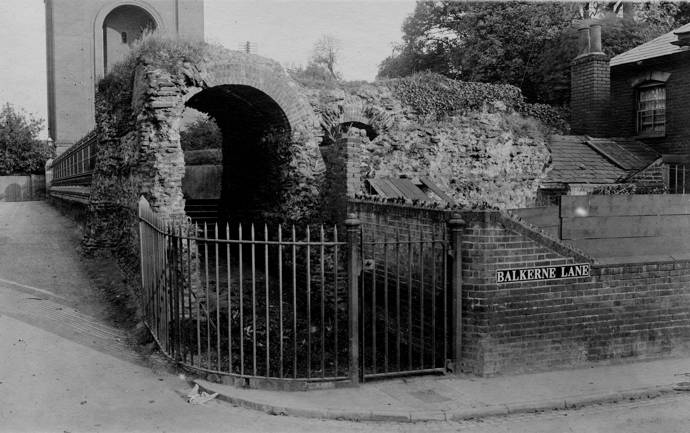In 2019-2020, a collaborative project was undertaken between Colchester Borough Council, BA Photography students from UCC Colchester Institute, Colchester Archaeological Trust and archaeological imaging consultant Prof. Dominic Powlesland, to generate an accurate 3D model of the Balkerne Gate.
The gate was recorded in detail with an overlapping grid of high-resolution digital photographs. The images were used to create a very accurate 3D surface model, and one that can be accessed from a multitude of vantage points and viewing distances. The principle method uses well-established computing algorithms, using Structure from Motion (SfM) to reconstruct 3D space from the multiple overlapping images. The results are shared using Sketchfab, which is dedicated to the publication and sharing of digital 3D models.
The 3D model is important for conservation recording and management of the Town Wall, serving as an accurate point-in-time record of the gate that can be revisited in the future to study alteration, erosion and damage.
More detailed information about the digital recording technique can be found in the Historic England good practice guidance Photogrammetric Applications for Cultural Heritage.
The results of the project are available here.
The Balkerne Gate was the main (west) gate into the walled Roman town and one of six gates around the circuit of the Town Wall. The Gate incorporated an existing free-standing monumental arch (with two archways) built to celebrate the Claudian conquest of Britain, probably in the AD 50s, and faced with tufa stone brought from the Hampshire coast. This created a double-arched gateway with flanking walkway arches and external guardrooms, 30m wide N to S, as shown in the reconstruction drawing below by Peter Gray. The archways formed the main carriageways with the addition of a footway and a bastion on both sides to form the Balkerne Gate.

In the late 3rd century, the Balkerne Gate was closed and the external defensive ditch was extended to close off the road (i.e. the ditch was dug across the carriageways). The monumental arch and part of the rest of the gate was demolished and the rubble used to block the gap; the south pedestrian walkway, however, seems to have been left open. The south-west gate, or Head Gate became the main gate into the town after the Balkerne Gate was blocked in the late 3rd century, and it was the principal gate into the later medieval town.
The surviving (southern) pedestrian archway of the Balkerne Gate, still in use today, and southern bastion (and also part of the northern bastion) is only a small part of what was once an impressive entrance into Colchester, in keeping with the importance of the town. The base of the blocked carriageways are visible below the parapet of the Hole in the Wall public house.

The Balkerne Gate in 1913. Notice the house that is built against the Wall, to the south of the Gate. This, and other buildings along Balkerne Lane, were demolished in advance of the construction of the dual carriageway in 1977.
Colchester’s Town Wall is the earliest and one of the most complete town wall circuits surviving from Roman Britain, dated to c.AD 65-80. The Wall was constructed in a calcareous mudstone, septaria, imported from an outcrop near Harwich, supplemented by courses of brick. Nearly two thirds of the wall circuit still exists with the remainder surviving as buried archaeological remains; originally the Wall formed a circuit 2.8km long and 2.4m thick, and enclosed a rectangular area of 48ha. Six gates were built in the Wall and internal rectangular towers were constructed on the inside of the Wall; today, there are the upstanding remains of only two gates, the Balkerne Gate and Duncan’s Gate.

A large defensive ditch, over 5m wide and 3m deep, was dug around the outer foot of the Wall, around the same time as the construction of the Wall. This ditch was subsequently recut and enlarged in c.AD 275. An interior rampart was also added to the Wall in the mid-2nd century AD.
The Wall was repaired and refurbished in AD 917 by Edward the Elder. A substantial ditch was cut along the south side of the Wall in the late 10th or 11th century, 7.5m wide and 3.0m deep. An extensive programme of repairs was carried out in the 14th century and eight bastions were added along the south-east circuit. One of the best preserved bastions, Bastion 5, is today situated in Priory Street car park. The Civil War was the last military action seen by the Town Wall.
Unlike many other town walls, subsequent alterations have not altered the essential character of the circuit and it continues to define the historic centre of the town. It is one of the most important historic features and visual reminders of the Roman town, as most of the Roman evidence is buried deep underground.
In 2019, Colchester Borough Council adopted a new management plan. The plan sets out a framework for the maintenance, enhancement, interpretation, presentation and celebration of the Town Wall and its setting.


